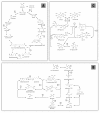The Zea mays mutants opaque-2 and opaque-7 disclose extensive changes in endosperm metabolism as revealed by protein, amino acid, and transcriptome-wide analyses
- PMID: 21241522
- PMCID: PMC3033817
- DOI: 10.1186/1471-2164-12-41
The Zea mays mutants opaque-2 and opaque-7 disclose extensive changes in endosperm metabolism as revealed by protein, amino acid, and transcriptome-wide analyses
Abstract
Background: The changes in storage reserve accumulation during maize (Zea mays L.) grain maturation are well established. However, the key molecular determinants controlling carbon flux to the grain and the partitioning of carbon to starch and protein are more elusive. The Opaque-2 (O2) gene, one of the best-characterized plant transcription factors, is a good example of the integration of carbohydrate, amino acid and storage protein metabolisms in maize endosperm development. Evidence also indicates that the Opaque-7 (O7) gene plays a role in affecting endosperm metabolism. The focus of this study was to assess the changes induced by the o2 and o7 mutations on maize endosperm metabolism by evaluating protein and amino acid composition and by transcriptome profiling, in order to investigate the functional interplay between these two genes in single and double mutants.
Results: We show that the overall amino acid composition of the mutants analyzed appeared similar. Each mutant had a high Lys and reduced Glx and Leu content with respect to wild type. Gene expression profiling, based on a unigene set composed of 7,250 ESTs, allowed us to identify a series of mutant-related down (17.1%) and up-regulated (3.2%) transcripts. Several differentially expressed ESTs homologous to genes encoding enzymes involved in amino acid synthesis, carbon metabolism (TCA cycle and glycolysis), in storage protein and starch metabolism, in gene transcription and translation processes, in signal transduction, and in protein, fatty acid, and lipid synthesis were identified. Our analyses demonstrate that the mutants investigated are pleiotropic and play a critical role in several endosperm-related metabolic processes. Pleiotropic effects were less evident in the o7 mutant, but severe in the o2 and o2o7 backgrounds, with large changes in gene expression patterns, affecting a broad range of kernel-expressed genes.
Conclusion: Although, by necessity, this paper is descriptive and more work is required to define gene functions and dissect the complex regulation of gene expression, the genes isolated and characterized to date give us an intriguing insight into the mechanisms underlying endosperm metabolism.
Figures






Similar articles
-
Transposable element rbg induces the differential expression of opaque-2 mutant gene in two maize o2 NILs derived from the same inbred line.PLoS One. 2014 Jan 9;9(1):e85159. doi: 10.1371/journal.pone.0085159. eCollection 2014. PLoS One. 2014. PMID: 24416355 Free PMC article.
-
Maize opaque endosperm mutations create extensive changes in patterns of gene expression.Plant Cell. 2002 Oct;14(10):2591-612. doi: 10.1105/tpc.003905. Plant Cell. 2002. PMID: 12368507 Free PMC article.
-
Molecular and biochemical mechanisms in maize endosperm development: the role of pyruvate-Pi-dikinase and Opaque-2 in the control of C/N ratio.C R Biol. 2008 Oct;331(10):772-9. doi: 10.1016/j.crvi.2008.07.019. Epub 2008 Sep 4. C R Biol. 2008. PMID: 18926491 Review.
-
ZmDof3, a maize endosperm-specific Dof protein gene, regulates starch accumulation and aleurone development in maize endosperm.Plant Mol Biol. 2017 Jan;93(1-2):7-20. doi: 10.1007/s11103-016-0543-y. Epub 2016 Oct 5. Plant Mol Biol. 2017. PMID: 27709320
-
Maize opaque mutants are no longer so opaque.Plant Reprod. 2018 Sep;31(3):319-326. doi: 10.1007/s00497-018-0344-3. Epub 2018 Jul 5. Plant Reprod. 2018. PMID: 29978299 Free PMC article. Review.
Cited by
-
The Zea mays mutants opaque2 and opaque16 disclose lysine change in waxy maize as revealed by RNA-Seq.Sci Rep. 2019 Aug 22;9(1):12265. doi: 10.1038/s41598-019-48478-6. Sci Rep. 2019. PMID: 31439855 Free PMC article.
-
Maize big embryo 6 reveals roles of plastidial and cytosolic prephenate aminotransferases in seed and plant development.Plant Cell. 2025 Jun 4;37(6):koaf067. doi: 10.1093/plcell/koaf067. Plant Cell. 2025. PMID: 40476681 Free PMC article.
-
The phylogeny of C/S1 bZIP transcription factors reveals a shared algal ancestry and the pre-angiosperm translational regulation of S1 transcripts.Sci Rep. 2016 Jul 26;6:30444. doi: 10.1038/srep30444. Sci Rep. 2016. PMID: 27457880 Free PMC article.
-
Genome-wide characterization of cis-acting DNA targets reveals the transcriptional regulatory framework of opaque2 in maize.Plant Cell. 2015 Mar;27(3):532-45. doi: 10.1105/tpc.114.134858. Epub 2015 Feb 17. Plant Cell. 2015. PMID: 25691733 Free PMC article.
-
Opaque7 encodes an acyl-activating enzyme-like protein that affects storage protein synthesis in maize endosperm.Genetics. 2011 Dec;189(4):1281-95. doi: 10.1534/genetics.111.133967. Epub 2011 Sep 27. Genetics. 2011. Retraction in: Genetics. 2023 Mar 2;223(3):iyac174. doi: 10.1093/genetics/iyac174. PMID: 21954158 Free PMC article. Retracted.
References
-
- Motto M, Thompson R, Salamini F. In: Cellular and Molecular Biology of Plant Seed Development. Larkins BA, Vasil IK, editor. 1997. Genetic regulation of carbohydrate and protein accumulation in seeds.
-
- Coleman CE, Larkins BA. In: Seed Proteins. Casey R, Shewry PR, editor. Kluwer Academic Publishers, Dordrecht, The Netherlands; 1998. Prolamines of maize.
Publication types
MeSH terms
Substances
LinkOut - more resources
Full Text Sources

